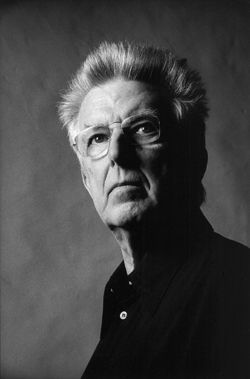Reynolds, Roger
Biography
Born: July 18, 1934
Country: Detroit, Michigan, U.S.A.
Studies: University of Michigan (B.M.1960, M.M.1961)
Teachers: Ross Lee Finney, Roberto Gerhard
Website: https://www.rogerreynolds.com/
Roger Reynolds: composer, writer, producer and mentor, pioneer in sound spatialization, intermedia and also algorithmic concepts, an inveterate synthesizer of diverse capacities and perspectives. His notorious (1961) composition, “The Emperor of Ice Cream,” which uses graphic notation to depict performer location on a stage, was widely imitated. In it, eight singers and a jazz trio gloss, while musically manifesting, a Wallace Stevens poem. In fact, Reynolds’s work often arises out of text. One of his Ircam commissions, “Odyssey” (1989-93) sets a bilingual Beckett text; his Pulitzer prize-winning composition, “Whispers Out of Time,” for string orchestra, muses over a poem by John Ashbery. The FLiGHT project arose out of a collection of texts that stretches from Plato to astronaut Michael Collins. This body of work demonstrates how seamlessly text, electroacoustic resources, and novel presentation strategies can be melded with live instrumental and vocal performance.
Projects with individual performers and ensembles, theater directors, choreographers, and scientists have provoked challenging inter-personal collaborations, including “Sanctuary” (2003-2007) for percussion quartet and real-time computer processing with Steven Schick. About it, Gramophone writes: “Reynolds goes right inside sound. … Here’s the most outstandingly original view of percussion since Varèse’s ‘Ionisation’.” A recent cycle of duos for solo instrumentalist and real-time computer musician includes “MARKed MUSIC” (with contrabassist Mark Dresser), and “Shifting/Drifting” (with violinist Irvine Arditti). About a Mode 2-disc set of Reynolds’s complete cello music featuring Alexis Descharmes, Gramophone wrote: “fresh-minted but also thrillingly open-ended …” In addition to continuing musical composition, Reynolds’s current projects include an innovative collection of texts and images, PASSAGE, and a collaborative book exploring Xenakis’s creative ways as exemplified in a Desert House he designed for Karen and Roger Reynolds.
Reynolds’s music is published exclusively by C.F. Peters Corporation, and his manuscripts are housed in a Special Collection at the Library of Congress, as well as at the Sacher Foundation in Basel. He has been commissioned by the Philadelphia, San Francisco, Los Angeles, BBC, and National symphonies and the Japan Philharmonic, and also by the British Arts Council, the French Ministry of Culture, Ircam, the Fromm, Rockefeller, Suntory, and Koussevitzky foundations. Reynolds’s students occupy leading positions at Harvard (Czernowin), SUNY Buffalo (Felder), University of Michigan (Daugherty), University of Florida (Koonce), and North Texas (May). Reynolds envisions his own path as entailing the principled weaving together of threads from tradition with novel provocations originating outside music. The elements (wind, fire, water) have spoken in his works beginning with the vocal storm in VOICESPACE I: “Still” (1975), and continuing in “Versions/Stages” and “The Red Act Arias”. Mythic themes are also frequently drawn upon. Reading about and research in psychoacoustics have affected his outlook. Research in the Sacher Foundation’s Collections resulted in publications about Varèse’s conceptualization of “space”: “The Last Word is Imagination: Parts I and II”. His long friendships with Cage, Nancarrow, Takemitsu and Xenakis also inform his outlook in procedural and personal ways. Reynolds conceives of composition as “a process of illumination”, a path toward (occasional) clarity in turbulent times. He seeks the satisfaction of proposing and experiencing unexpected connections, of bringing the elevating capacity of music into public spaces, of engaging with other arts and artists to discover new amalgamations of sensation and insight that can “improve the human experience”. [1]
Works for Percussion
"... the serpent-snapping eye" - Multiple Percussion, Trumpet, Piano, with Tape
"...from behind the unreasoning mask" - Multiple Percussion, Trombone, with Tape
Autumn Island (Islands from Archipelago: II) - Marimba
Less than Two - Percussion Duo, Piano, with Tape
Sanctuary - Percussion Quartet, with Electronics, with Lighting
Sanctuary Part I: Chatter/Clatter - Multiple Percussion, with Electronics
Sanctuary Part II: Oracle - Percussion Quartet, with Electronics, with Lighting
Watershed I - Multiple Percussion
Watershed III - Multiple Percussion, Orchestra; Optional real-time computer sound spatialization
Watershed IV - Multiple Percussion, Real-time computer sound spatialization
References
